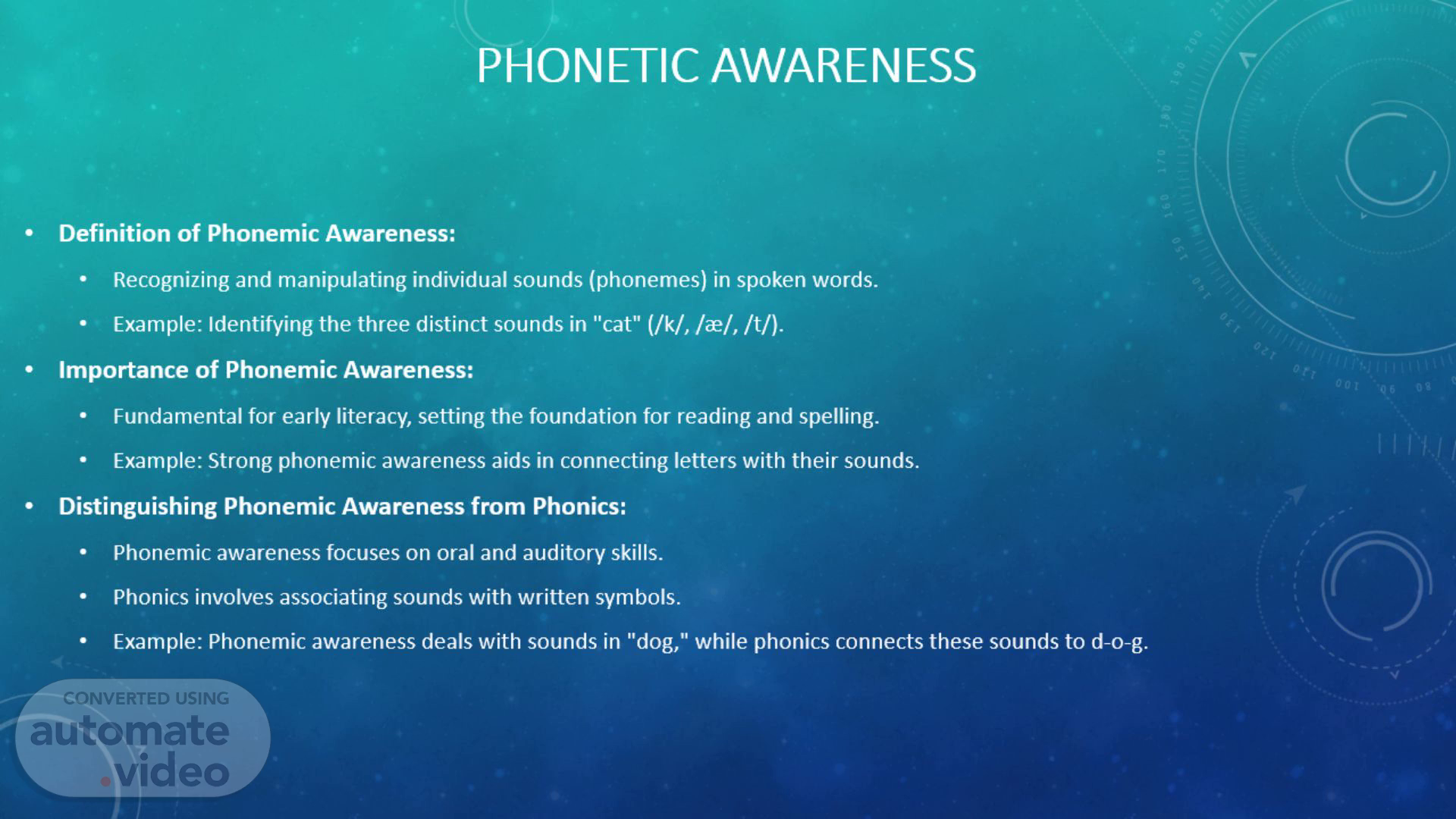Scene 1 (0s)
[Audio] Welcome to our presentation on 'Building the Foundation: Understanding Phonemic Awareness.' Today, we explore the essential skill of phonemic awareness, a key element in a child's journey to literacy. Phonemic awareness is the ability to recognize and manipulate individual sounds in spoken words, providing a crucial foundation for reading and spelling. Let's begin by distinguishing phonemic awareness from phonics. While phonemic awareness deals with sounds in spoken language, phonics involves connecting these sounds to written symbols..
Scene 2 (1m 2s)
[Audio] Now, let's delve into the components of phonemic awareness, which include phoneme isolation, blending, segmentation, and manipulation. Phoneme isolation involves recognizing individual sounds in words, such as identifying the first sound in 'sun. Blending requires combining sounds to form complete words, like blending /c/, /a/, and /t/ to create 'cat.' Segmentation is breaking words into individual sounds, demonstrated by clapping for each sound in a word like 'fish.' Finally, manipulation involves changing, adding, or deleting sounds in words, a skill vital for phonemic awareness development..
Scene 3 (1m 46s)
[Audio] Now, let's explore practical strategies for building phonemic awareness skills, both for parents and educators. Reading aloud is a powerful strategy. Emphasize sounds while reading rhyming books, like those written by Dr. Seuss. Nursery rhymes and songs with repetitive sounds enhance rhythm and phonemic awareness. For example, singing 'The Itsy Bitsy Spider' emphasizes the /s/ sound. Engaging in word games and using manipulatives, such as letter magnets, can make learning more interactive and enjoyable. Remember, progress monitoring is essential. Regular assessments help identify strengths and areas needing improvement, ensuring effective support..
Scene 4 (2m 37s)
[Audio] Moving forward, let's discuss the integration of phonemic awareness into reading instruction. Phonemic awareness serves as a foundation for successful phonics instruction. A child who can segment sounds in spoken words is better prepared to decode written words. In the classroom, integrate phonemic awareness activities into daily routines. Start the day with a rhyming word and discuss related words to reinforce learning. Remember to differentiate instruction based on individual needs. Providing extra support for students struggling with specific skills ensures a tailored learning experience..
Scene 5 (3m 19s)
[Audio] As we conclude, let's recap our key takeaways. Phonemic awareness is vital for early literacy. It involves recognizing and manipulating sounds in spoken words, laying the foundation for reading and spelling. Effective strategies, such as reading aloud, incorporating nursery rhymes, and using manipulatives, enhance phonemic awareness skills. Integration into reading instruction is essential for a seamless transition to phonics and decoding written words. Encourage ongoing support at home and in educational settings. Recognize progress and address challenges collaboratively for the child's continued success. Thank you for joining us today. We invite any questions or discussions and look forward to further collaboration in supporting our children's literacy development..
